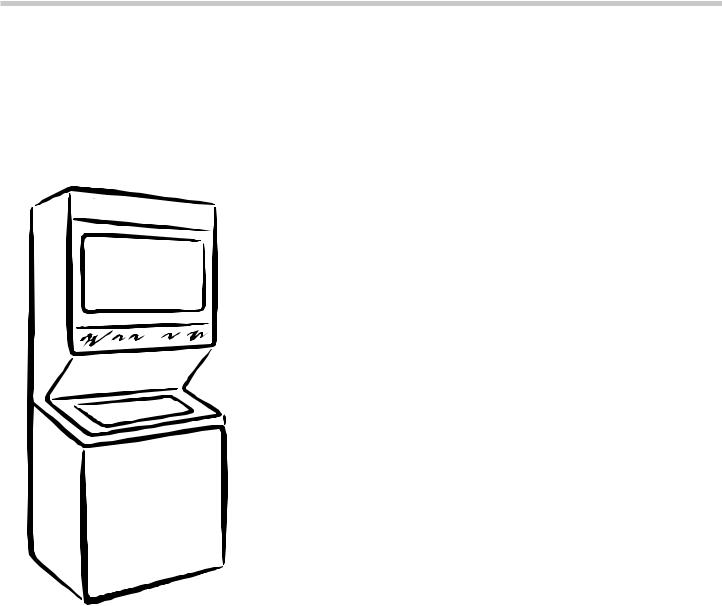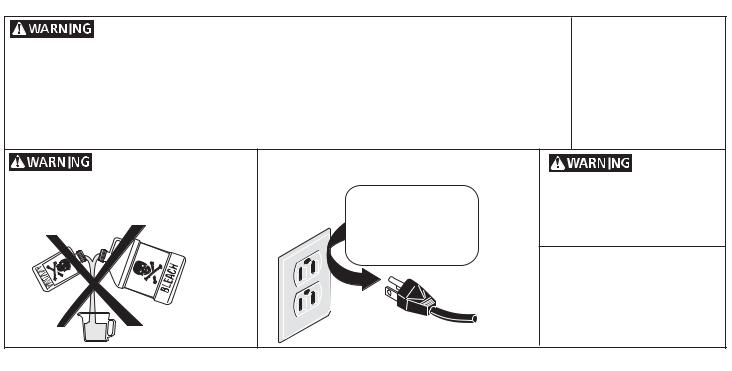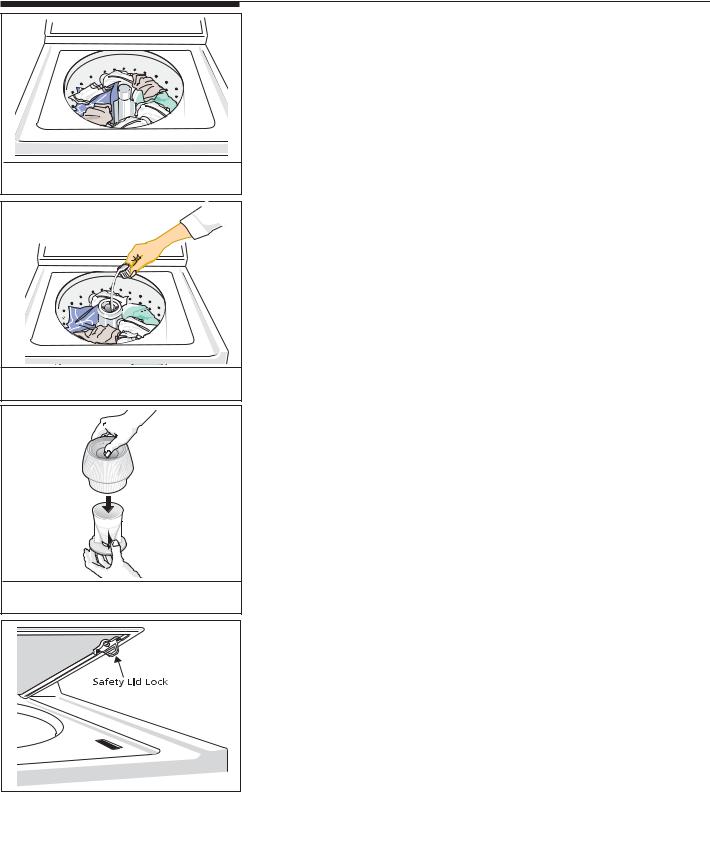Frigidaire FEX831FS, FEX831F Manual

LAUNDRY CENTER
Owner's Guide
LAVADORA Y SECADORA SUPERPUESTAS
Manual Del Usuario
Table of Contents |
|
ImportantSafetyInstructions........................................... |
2 |
WashingProcedures..................................................... |
3-4 |
StainRemoval.................................................................. |
5 |
Common Washing Problems.......................................... |
6 |
DryingProcedures........................................................... |
7 |
Features............................................................................ |
8 |
CommomDryingProblems............................................. |
8 |
CareandCleaning..................................................... |
9-10 |
Avoid Service Checklist........................................... |
10-12 |
WarrantyandService.................................................... |
13 |
Español..................................................................... |
14-27 |
Instrucciones Importantes de Seguridad................ |
14-15 |
Métodos deLavado................................................ |
16-18 |
LimpiezadeManchas.............................................. |
18-19 |
Problemas Comunes del Lavado.................................. |
20 |
MétodosdeSecado....................................................... |
21 |
Caracteristicas................................................................ |
22 |
Problemas Comunes de Secado................................... |
22 |
Cuidado y Limpieza ................................................ |
23-24 |
Lista de Control de Averías..................................... |
24-26 |
GarantÍa.......................................................................... |
27 |
|
Product Registration |
Read and Save These Instructions |
|
|||||
|
Thank you for choosing this |
Record Your Model and Serial Numbers |
|
|||||
|
dryer. This owner's guide will |
|
||||||
|
Record below the model and serial numbers found on the laundry center serial |
|
||||||
|
explain proper operation and care. |
|
||||||
|
plate located on the inside of the dryer door. Keep these numbers for future |
|
||||||
|
Register Your Product |
|
||||||
|
reference. |
|
||||||
|
The self-addressed PRODUCT |
|
||||||
|
|
|
|
|
|
|
|
|
|
REGISTRATION CARD should be |
Anote su Número de Modelo y de Serie |
|
|||||
|
filled in completely, signed and |
|
||||||
|
returned. |
Anote a continuación el número de modelo y de serie que se encuentran en |
|
|||||
|
Registro del Producto |
la placa de serie situada en el interior de la puerta de la secadora. Conserve |
|
|||||
|
estos números para referencia futura. |
|
||||||
|
Le agradecemos que haya seleccio- |
|
||||||
|
|
|
|
|
|
|
|
|
|
nado esta secadora. En este manual |
Model Number: |
|
|||||
|
del usuario encontrará las intrucciones |
|
||||||
|
Número de Modelo: |
|
|
|
|
|
||
|
apropiadas para su funcionamiento y |
|
|
|
||||
|
Serial Number: |
|
||||||
|
cuidado. |
|
||||||
|
Registre su Producto |
Número de Serie: |
|
|
|
|
|
|
|
|
|||||||
|
La TARJETA DE REGISTRO DEL |
Purchase Date: |
|
|||||
|
PRODUCTO ya dirigida debe ser |
Fecha de compra: |
|
|
|
|
||
|
||||||||
|
llenada, firmada y enviada. |
|
|
|
|
|
|
|
|
|
|
|
|
|
|
|
|
|
|
|
|
|
|
|
|
|
www.frigidaire.com |
1 |
PN 134809600 (0610) |

For your safety, the information in this manual must be followed to minimize the risk of fire or explosion This Owner's Guide provides |
|
or to prevent property damage, personal injury or loss of life. |
general operating instructions |
-Do not store or use gasoline or other flammable vapors and liquids in the vicinity of this or any other appliance. for your laundry center. It also
- |
WHAT TO DO IF YOU SMELL GAS: |
contains |
information |
about |
||
|
• |
Do not try to light any appliance. |
||||
|
features |
for several |
other |
|||
|
• |
Do not touch any electrical switch; do not use any phone in your building. |
||||
|
models. Your laundry center may |
|||||
|
• |
Clear the room, building or area of all occupants. |
||||
|
not have every feature included. |
|||||
|
• |
Immediately call your gas supplier from a neighbor's phone. Follow the gas supplier's instructions. |
||||
|
Use the laundry center only as |
|||||
|
• |
If you cannot reach your gas supplier, call the fire department. |
||||
|
instructed in this Owner's Guide. |
|||||
Installation and service must be performed by a qualified installer, service agency or the gas supplier. |
||||||
|
|
|
||||
Do not use or mix liquid chlorine |
Grounding type |
|
Avoid fire hazard |
||
wall receptacleGAS LAUNDRY CENTERS: |
|
||||
bleach with other household chemicals such as toilet |
or electrical shock. Do not use an |
||||
|
|
||||
cleaners, rust removers, acid or products containing |
|
Do notunder |
adaptor plug or extension cord or |
||
ammonia. These mixtures can produce dangerous |
Grounding type |
anycircumstances |
remove grounding prong from |
||
fumes which can cause serious injury or death. |
wall receptacle |
cut,remove, |
electrical power cord. Failure to follow |
||
|
|
or bypass |
this warning can cause serious injury, |
||
|
|
the groundingprong |
fire or death. |
|
|
|
|
fromthisplug. |
Note: The instructions appearing |
||
|
|
Power supply |
in this Owner's Guide are not meant |
||
|
|
to cover every |
possible condition |
||
|
|
cord with 3-prong |
and situation |
that may occur. |
|
|
|
grounding plug |
|||
|
|
Common sense and caution must |
|||
|
|
|
|||
|
|
CORRECT |
be practiced |
when installing, |
|
|
|
Power supply |
operating and |
maintaining any |
|
|
Use this way ONLY |
appliance. |
|
||
|
|
cord ith 3-prong |
|
||
Important Safety Instructions |
|
grounding plug |
|
|
|
|
Read all instructions before using this laundry center. |
||||




 You can be killed or seriously injured if you don't follow these Important Safety Instructions:
You can be killed or seriously injured if you don't follow these Important Safety Instructions:
•To reduce the risk of fire, electrical shock, or injury to persons when using this laundry center, comply with the basic warnings listed below.
•Failure to comply with these warnings could result in serious personal injuries.
Prevent Fire
•Do not wash or dry items that have been previously cleaned in, soaked in, or spotted with gasoline, cleaning solvents, kerosene, waxes, etc. Do not store these items on or near the dryer. These substances give off vapors that could ignite or explode.
•Do not place items exposed to cooking oils in your dryer. Items contaminated with cooking oils may contribute to a chemical reaction that could cause a load
to catch fire.
•Do not put oily or greasy rags or clothing on top of the laundry center. These substances give off vapors that could ignite the materials.
•Do not add gasoline, cleaning solvents, or other flammable or explosive substances to the wash water. These substances give off vapors that could ignite or explode.
•Under certain conditions, hydrogen gas may be produced in a hot water system that has not been used for 2 weeks or more. HYDROGEN GAS IS EXPLOSIVE. If the hot water system has not been used for such a period, before using the washer, turn on
all hot water faucets and let the water flow from each for several minutes. This will release any accumulated hydrogen gas. Hydrogen gas is flammable; do not smoke or use an open flame during this time.
•To prevent fire, do not use heat to dry items containing plastic, foam rubber or similarly textured rubber-like materials, or items containing feathers or down. Use Air Fluff (No Heat) only.
•Clean the dryer lint screen before or after each load. The interior of the dryer, lint screen housing and exhaust duct should be cleaned approximately every 18 months by qualified service personnel. An excessive amount of lint build-up in these areas could result in inefficient drying and possible fire.
See Care and Cleaning.
•Do not operate the dryer if the lint screen is blocked, damaged or missing. Fire hazard, overheating and damage to fabrics can occur. If your dryer has a drying rack, always replace the lint screen when finished using the drying rack.
•Keep area around the exhaust opening and surrounding areas free from the accumulation of lint, dust and dirt.
•Do not obstruct the flow of ventilating air. Do not stack or place laundry or throw rugs against the front or back of the laundry center.
•Do not spray any type of aerosol into, on or near laundry center at any time.
•Do not use fabric softeners or products to eliminate static unless recommended by the manufacturer of the fabric softener or product.
•Failure to comply with these warnings could result in fire, explosion, serious bodily injury and/or damage to the rubber or plastic parts of the laundry center.
Protect Children
•Do not allow children to play on or in the laundry center. Close supervision of children is necessary when the laundry center is used near children. As children grow, teach them the proper, safe use of all appliances.
•Destroy the carton, plastic bag and other packing materials after the laundry center is unpacked. Children might use them for play. Cartons covered with rugs, bedspreads or plastic sheets can become airtight chambers.
•Keep laundry products out of children's reach. To prevent personal injury, observe all warnings on product labels.
•Before the laundry center is removed from service or discarded, remove the washer lid and dryer door to prevent accidental entrapment.
•Failure to comply with these warnings could result in serious personal injuries.
Prevent Injury
•To prevent shock hazard and assure stability during operation, the laundry center must be installed and electrically grounded by a qualified service person in accordance with local codes. Installation instructions are packed in the laundry center for the installer's reference. Refer
to INSTALLATION INSTRUCTIONS for detailed grounding procedures. If the laundry center is moved to a new location, have it checked and
reinstalled by a qualified service person. |
2 |
Printed in U.S.A. |
|
||
|
|

Important Safety Instructions Con't
•To prevent personal injury or damage to the laundry center, the electrical power cord of a gas laundry center must be plugged into a properly grounded system. Never ground the laundry center to a gas pipe. Do not use an extension cord or an adaptor plug.
•Follow package directions when using laundry products. Incorrect usage can produce poisonous gas--resulting in serious injury or death.
-Do not combine laundry products for use in 1 load unless specified on the label.
-Do not mix chlorine bleach with ammonia or acids such as vinegar.
WashingProcedures
Sort laundry into loads that can be washed together.
•Follow the guidelines below for preparing the wash load.
•Read the Washer Operating Instructions for operating your specific model.
•Always read and follow fabric care and laundry product labels.




 To reduce the risk of fire, electrical shock, or injury to persons, read Important Safety Instructions, page 2-3, before operating this washer.
To reduce the risk of fire, electrical shock, or injury to persons, read Important Safety Instructions, page 2-3, before operating this washer.
1. Sort laundry into loads that can be washed together.
Sort items by recommended water temperatures, wash time, and agitate/spin speeds.
•Separate white, light, and colorfast items from dark and noncolorfast items.
•Separate items which shed lint from items which attract lint. Permanent press, synthetic, knit and corduroy items will pick up lint from towels, rugs and chenille bedspreads.
•Separate heavily soiled items from lightly soiled items.
•Separate lacy, sheer and loosely knit items from sturdy items.
Empty pockets.
2.Prepare items for washing.
•Empty pockets.
•Brush off lint and dirt. Shake out rugs and beach towels.
•Close zippers, fasten hooks, tie strings and sashes, and remove nonwashable trims and ornaments.
•Remove pins, decorative buttons, belt buckles, and other objects which could be damaged. This also helps protect other items in the wash load.
•Mend rips and tears to prevent further damage during washing.
•Place delicate items such as bras, shoulder pads, hosiery, and belts in a mesh bag to prevent tangling during the wash cycle.
•Turn knit items inside out to prevent pilling.
Place delicate items in a mesh bag.
Bleach Dispenser (some models) |
3. Pretreat stains and heavy soil.
See Stain Removal, page 5, for details.
4. Add a measured amount of detergent to the wash tub before adding the laundry load.
Follow detergent manufacturer's directions. The amount required depends on type of detergent, load size and soil level, and water hardness.
5. If desired, add liquid bleach to Bleach Dispenser (available on
some models).
•Before adding the wash load, add liquid bleach to bleach dispenser located in left front corner under the lid:
•3/4 cup (180 ml) for small loads
•1 cup (240 ml) for large loads
•1-1/4 cups (300 ml) for extra-large loads.
•Then add 1 cup (240 ml) water to flush the dispenser.
•Do not use powdered bleach in the bleach dispenser. Add powdered bleach to the empty tub.
For models without a bleach dispenser, dilute the recommended amount of liquid chlorine bleach in 1 quart (.95 L) water. Add it to wash water after
a few minutes of agitation. Do not pour bleach directly on wash load.
3

Do not load items higher than top of agitator vanes.
Built-In Fabric Softener Dispenser |
(some models) |
Washing Procedures (continued)
6.Add laundry load to washer.
•Dry load level should not be higher than the top of agitator vanes.
Do not overload the washer.
•Do not put items on top of agitator or wrap them around it. Load items evenly.
•Combine large and small items in a load. Load large items first. Large items should not be more than half the total wash load.
•When washing a single heavy item, add 1 or 2 towels to balance the load.
7.If desired, add liquid fabric softener to Fabric Softener
Dispenser (available on some models).
For models with a built-in dispenser (see picture to the left):
1.Add liquid softener to the dispenser, following fabric softener label directions.
2.Add water to bring liquid level to fill line on dispenser cap.
3.Remove the dispenser from the agitator after each use. Rinse both cap and cup with warm water. Replace dispenser in the agitator.
NOTE: To separate cap from cup, put thumb into dispenser and push against side of cup (see picture to the left). After cleaning, push cap and cup firmly together. Replace dispenser by lining up the ribs and grooves and snapping it into position. If fabric softener builds up in or around the dispenser, clean the area with hot water.
DO NOT REMOVE SERVICE CAP FOUND INSIDE THE AGITATOR POST.
Built-In Fabric Softener Dispenser
(some models)
For models without a fabric softener dispenser, follow fabric softener label directions. Add diluted fabric softener to the final rinse. Do not pour fabric softener directly on the wash load.
8. Select cycle and settings according to type, size, and soil level of each load .
See Operating Instructions for your specific model controls.
9. Start the washer.
Close the washer lid and pull out the cycle selector knob. The washer will not agitate or spin with the lid open.
•To stop the washer, push in the cycle selector knob.
•To change a cycle, push in the cycle selector knob. Turn it clockwise to the desired setting. Pull out the knob to restart the washer.
10.Remove items when the cycle is completed.
For your safety, the lid locks when the tub is spinning. It will remain locked for 2- 3 minutes after the tub stops spinning.
•To open the lid during a spin, push in the cycle selector knob and wait about 2-3 minutes for the lid lock to release. Do not force open the locked lid.
Place washed items in automatic dryer, line dry, or dry flat as directed by fabric care label. Excess wrinkling, color transfer or odors may develop in items left in the washer after the cycle has ended.

 To avoid serious personal injury, do not operate washer if safety lid lock is missing or damaged.
To avoid serious personal injury, do not operate washer if safety lid lock is missing or damaged.
4
